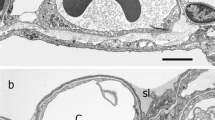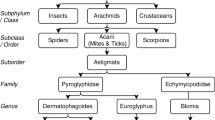Summary
1,2-Diformylhydrazine was administered in drinking water as a 2% solution to randomly bred Swiss albino mice for life from 6 weeks of age. As a result of treatment, the lung tumor incidence rose from 15 to 96% in females and from 22 to 82% in males. The treatment had no statistically significant effect on the development of other types of tumors. Histopathologically, the neoplasms exhibited the characteristic appearance of adenomas and adenocarcinomas of the lungs.
The work is part of a series of studies aimed at revealing the relative carcinogenic potency of mono and dialkyl-hydrazines and also their possible environmental significance as cancer causative agents.
Zusammenfassung
1,2-Diformylhydrazin wurde in einer 2%igen Lösung 6 Wochen alten Swiss-Mäusen auf Dauer im Trinkwasser verabreicht. Die Lungentumor-Häufigkeit stieg von 15% (in Kontrollen) auf 96% in weiblichen und von 22% auf 82% in männlichen Tieren. Histopathologisch besaßen diese Neoplasmen die charakteristische Erscheinungsform von Adenom und Adenokarzinom der Lunge. Die Behandlung zeigte keine erkennbare Wirkung hinsichtlich der Entwicklung anderer Tumoren.
Diese Arbeit ist Teil einer Untersuchungsreihe, welche die relative karzinogene Wirkung von Mono und Dialkylhydrazinen und deren eventuelle Bedeutung als krebserzeugende Substanzen der Umwelt zeigen soll.
Similar content being viewed by others
References
Armitage, P.: Statistical Methods in Medical Research, pp. 135–138. Oxford: Blackwell 1971
Daniels, E.G., Kelly, R.B., Hinman, J.W.: Agaritine, an improved isolation procedure and confirmation of structure by synthesis. J. Am. Chem. Soc. 83, 3333–3334 (1961)
Kondo, S., Shibahara, S., Takahashi, S., Meada, K., Umezawa, H., Ohno, M.: Negamycin, a novel hydrazide antibiotic. J. Am. Chem. Soc. 93, 6305–6306 (1971)
La Rue, T.A.: Naturally occurring compounds containing a nitrogen-nitrogen bond. Lloydia 40, 307–321 (1977)
Levenberg, B.: Structure and enzymatic cleavage of agaritine, a new phenylhydrazide of L-glutamic acid isolated from Agricaceae. J. Am. Chem. Soc. 83, 503–504 (1961)
List, P.H., Luft, P.: Gyromitrin, das Gift der Frühjahrlorchel. Arch. Pharm. 301, 294–305 (1968)
Liu, Y.Y., Schmeltz, I., Hoffmann, D.: Chemical studies on tobacco smoke. Quantitative analysis of hydrazine in tobacco and cigarette smoke. Anal. Chem. 46, 885–889 (1974)
Schmeltz, I., Abidi, S., Hoffmann, D.: Tumorigenic agents in unburned processed tobacco: N-nitrosodiethanolamine and 1,1-dimethylhydrazine. Cancer Lett. 2, 125–132 (1977)
Schmidlin-Mészáros, J.: Gyromitrin in Trockenlorcheln (Gyromitra esculenta sicc.). Mitt. Geb. Lebersm. Hyg. 65, 453–465 (1974)
Takasawa, S., Yamamoto, M., Akachi, R., Kawamoto, I., Sato, S., Nara, T.: A new antibiotic XK-90. I. Taxonomy of the producing organism, fermentation, isolation and physicochemical and biological properties. J. Antibiot. 29, 1015–1018 (1976)
The Merck Index, 9th edition. Rahway, N.J.: Merck and Co., Inc. 1976
Toth, B.: A toxicity method with calcium cyclamate for chronic carcinogenesis experiments. Tumori 58, 137–142 (1972a)
Toth, B.: Hydrazine, methylhydrazine and methylhydrazine sulfate carcinogenesis in Swiss mice. Failure of ammonium hydroxide to interfere in the development of tumors. Int. J. Cancer 9, 109–118 (1972b)
Toth, B.: 1,1-Dimethylhydrazine (unsymmetrical) carcinogenesis in mice. Light microscopic and ultrastructural studies on neoplastic blood vessels. J. Natl. Cancer Inst. 50, 181–194 (1973)
Toth, B.: Synthetic and naturally occurring hydrazines as possible cancer causative agents. Cancer Res. 35, 3693–3697 (1975)
Toth,B.: Additional series of carcinogenic hydrazines. To be presented at the XII. International Cancer Congress (in press) (1978)
Toth,B.: Formylhydrazine carcinogenesis in mice. Brit. J. Cancer (in press) (1978)
Toth, B., Nagel, D., Erickson, J., Kupper, R.: Tumorigenicity of tetramethylhydrazine hydrochloride in Swiss mice. J. Natl. Cancer Inst. 67, 1179–1183 (1976)
Toth, B., Shimizu, H.: 1-Carbamyl-2-phenylhydrazine tumorigenesis in Swiss mice. Morphology of lung adenomas. J. Natl. Cancer Inst. 52, 241–251 (1974)
Toth, B., Wilson, R.B.: Blood vessel tumorigenesis by 1,2-dimethylhydrazine dihydrochloride (symmetrical). Gross, light and electron microscopic descriptions. I. Am. J. Pathol. 64, 585–600 (1971)
Author information
Authors and Affiliations
Additional information
Supported by USPHS Contract N01 CP33278 from the National Cancer Institute, NIH, USA
Rights and permissions
About this article
Cite this article
Toth, B., Erickson, J. Lung tumorigenesis by 1,2-diformylhydrazine in mice. Z. Krebsforsch. 92, 11–16 (1978). https://doi.org/10.1007/BF00284090
Received:
Accepted:
Issue Date:
DOI: https://doi.org/10.1007/BF00284090




